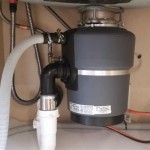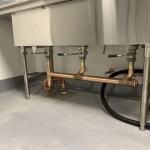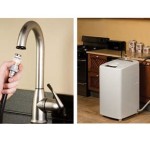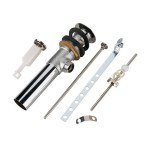Sink Stinks When Running Water: Identifying and Resolving the Issue
A foul odor emanating from a sink drain when water is running is a common household problem, often indicative of underlying issues within the plumbing system. This unpleasant experience can range from a subtle musty smell to a more pungent, offensive odor, significantly impacting the comfort and hygiene of the living space. The cause of this issue is rarely singular; it is often a combination of factors contributing to the build-up of organic matter and the proliferation of odor-producing bacteria within the drain system. Understanding the potential sources of the stench and the corrective measures available is crucial for effectively addressing and preventing recurrence of the problem.
The problem isn't merely an inconvenience. Prolonged exposure to certain types of drain odors can potentially pose health risks, particularly for individuals with pre-existing respiratory conditions or sensitivities. Moreover, the continuing presence of such odors can signal a more significant plumbing problem that, if left unaddressed, could lead to costly repairs. Therefore, it's imperative to promptly investigate the source of the odor and implement appropriate solutions to restore a clean and healthy environment.
Understanding the Common Culprits Behind Drain Odors
Identifying the root cause of the sink odor is the first step toward effective resolution. Several factors contribute to this problem, each requiring a specific approach for remediation. The most common causes include the accumulation of organic waste, the presence of a dry or malfunctioning P-trap, and the growth of bacteria and biofilm within the drain lines. Each of these factors are expanded in more detail below.
Organic waste accumulation is a primary suspect in producing drain odors. Food particles, hair, soap scum, and other organic debris inevitably enter the drainpipes. Over time, this material decomposes, creating a breeding ground for bacteria and other microorganisms. The decomposition process releases gases, such as hydrogen sulfide, which are responsible for the characteristic rotten egg smell often associated with drain problems. The type and quantity of waste disposed of in the sink directly influence the severity of the odor. For instance, coffee grounds, which are highly absorbent and prone to clumping, and fats, oils, and grease (FOG), which solidify within the drain lines, can significantly contribute to the buildup of organic matter.
The P-trap, a U-shaped section of pipe located under the sink, plays a critical role in preventing sewer gases from entering the living space. The P-trap is designed to hold a small amount of water, creating a seal that blocks the passage of gases from the sewer system. When the P-trap dries out due to infrequent use or evaporation, the seal is broken, allowing sewer gases to escape into the room. This is particularly common in infrequently used sinks, such as those in guest bathrooms or basement utility areas. Furthermore, a malfunctioning P-trap, which might occur due to leaks or improper installation, can also compromise its ability to maintain a proper seal, leading to odor issues.
The drain lines themselves can harbor bacteria and biofilm, a slimy layer of microorganisms that adheres to the interior surfaces of the pipes. Biofilm provides a protective environment for bacteria, shielding them from disinfectants and other cleaning agents. As the bacteria metabolize organic matter, they release volatile organic compounds (VOCs) that contribute to unpleasant odors. The warmer and wetter the environment within the drain lines, the more conducive it is to biofilm formation and bacterial growth. Certain types of bacteria produce specific odors, which can help pinpoint the source of the problem. For example, sulfur-reducing bacteria are responsible for the characteristic rotten egg smell, while other types of bacteria may produce musty or moldy odors.
Troubleshooting and Diagnostic Techniques
Before implementing any solutions, a thorough assessment of the problem is essential. This involves a process of elimination and careful observation to identify the specific source of the odor. A systematic approach to troubleshooting will help narrow down the potential causes and guide the selection of appropriate remedies. Some initial diagnostic steps are outlined below to aid in the troubleshooting process.
Begin by inspecting the sink and surrounding area for any visible signs of debris or mold growth. Check the drain opening for accumulated hair, soap scum, or food particles. Examine the underside of the sink for any signs of leaks or water damage, which could indicate a malfunctioning P-trap or other plumbing issues. Pay close attention to the frequency and intensity of the odor. Does it only occur when running water, or is it present at all times? Is the odor stronger in one sink compared to others in the house? This information can provide valuable clues about the source of the problem. Another important step is to assess the frequency of sink usage. Infrequently used sinks are more prone to P-trap drying and subsequent odor issues. Consider whether the odor coincided with any recent plumbing work or the use of new cleaning products, as these factors could also be contributing to the problem.
To determine if the P-trap is the source of the odor, try running water in the sink for a few minutes. This should replenish the water in the P-trap and restore the seal. If the odor disappears after running the water, a dry P-trap is likely the culprit. If the odor persists, the problem may lie elsewhere in the drain system. Another test is to pour a small amount of mineral oil into the drain. The mineral oil will float on top of the water in the P-trap, creating a barrier that prevents evaporation and blocks the passage of sewer gases. If the odor disappears after adding mineral oil, it confirms that a dry P-trap is the primary source of the problem.
If the P-trap is not the cause, the next step is to investigate the drain lines for organic waste buildup. One method is to use a flexible plumbing snake or auger to probe the drain lines and remove any accumulated debris. This can be particularly effective for clearing clogs and removing hair or other obstructions that may be contributing to the odor. Another option is to use a drain camera to visually inspect the interior of the drain lines. Drain cameras are equipped with a small camera and a flexible cable, allowing them to navigate through the pipes and provide a clear view of any obstructions or buildup. This can help identify the location and extent of the problem, enabling targeted cleaning and treatment.
Effective Cleaning and Remediation Strategies
Once the source of the odor has been identified, appropriate cleaning and remediation strategies can be implemented. The specific approach will depend on the nature and severity of the problem. A combination of mechanical cleaning, chemical treatments, and preventative measures is often necessary to effectively eliminate the odor and prevent its recurrence. Some effective techniques for cleaning and remediating drain odors are expanded below.
Mechanical cleaning methods are essential for removing physical obstructions and debris from the drain lines. This can be accomplished using a variety of tools, including plungers, plumbing snakes, and drain augers. Plungers are effective for dislodging minor clogs and creating suction to remove debris. Plumbing snakes and drain augers are more suitable for clearing larger clogs and removing stubborn obstructions from the drain lines. When using these tools, it is important to exercise caution to avoid damaging the pipes. Avoid using excessive force, and carefully follow the manufacturer's instructions. For more severe clogs, it may be necessary to disassemble the drainpipes to manually remove the obstruction.
Chemical treatments can be used to dissolve organic waste and kill odor-producing bacteria. A variety of drain cleaners are available, ranging from enzymatic cleaners to chemical drain openers. Enzymatic cleaners contain enzymes that break down organic matter, such as food particles and hair. These cleaners are relatively safe for use in all types of pipes and are environmentally friendly. Chemical drain openers, on the other hand, contain harsh chemicals, such as sodium hydroxide or sulfuric acid, that can dissolve stubborn clogs and kill bacteria. These cleaners are more effective than enzymatic cleaners for severe clogs, but they can also be corrosive and damaging to pipes. It is important to use chemical drain openers with caution and to carefully follow the manufacturer's instructions. Always wear protective gloves and eye protection when using these products. An alternative chemical treatment involves the use of baking soda and vinegar. This combination creates a fizzing action that can help loosen debris and neutralize odors. Pour one cup of baking soda down the drain, followed by one cup of vinegar. Allow the mixture to sit for 30 minutes, then flush the drain with hot water.
Preventative measures are crucial for maintaining a clean and odor-free drain system. These measures include regularly flushing the drain with hot water, avoiding the disposal of grease and food scraps down the sink, and using drain screens to catch hair and other debris. Flushing the drain with hot water helps to dissolve grease and prevent the buildup of organic matter. Avoid pouring fats, oils, and grease (FOG) down the drain, as these substances can solidify within the pipes and contribute to clogs and odors. Use drain screens or strainers to catch hair, food particles, and other debris before they enter the drainpipes. Regularly clean the drain screens to prevent them from becoming clogged and contributing to odor problems. Consider using a drain maintenance product on a regular basis to help prevent the buildup of organic matter and biofilm.

How To Clean A Stinky Sink Drain

Deodorize A Kitchen Sink That Smells 5 Ways Youtube

How To Clean A Stinky Sink Drain Home Repair Tutor

Why Does My Bathroom Sink Smell How Do I Resolve It

Why Does My Water Smell Culligan Quench

How To Clean A Smelly Drain Liquid Plumr

Your Household Water Quality Odors In Uga Cooperative Extension

How To Clean A Smelly Drain Easy Diy Fixes For Foul Odors

How To Remove Musty Odors From Kitchen Sink Water Damage

How To Get Rid Of A Smelly Sink Drain 10 Ways Proven Work







